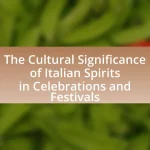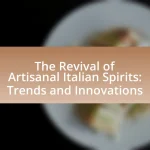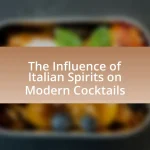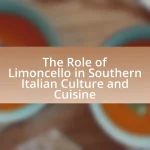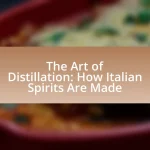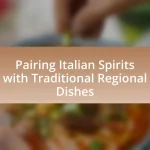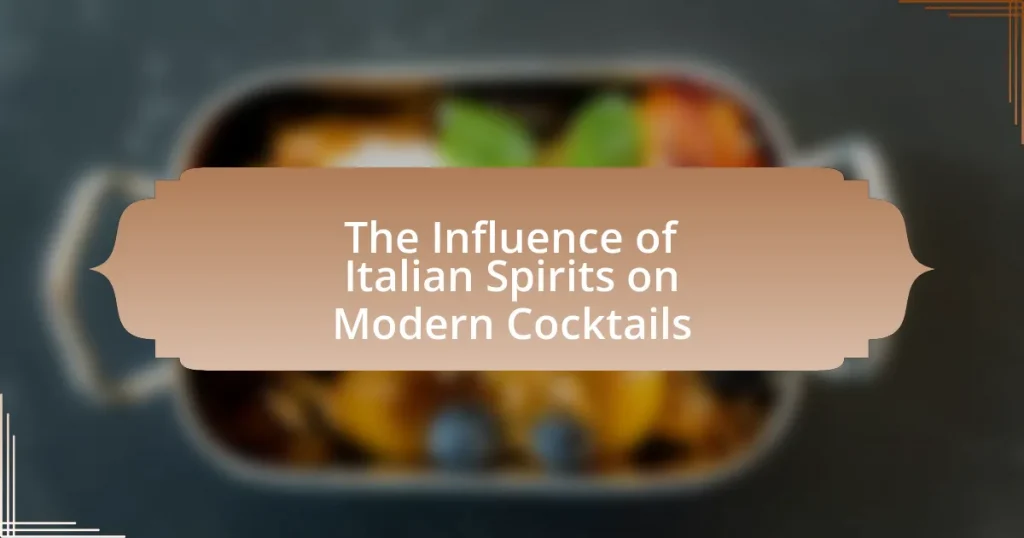Italian spirits, including grappa, amaro, vermouth, and limoncello, are integral to Italy’s cultural and culinary heritage, influencing modern cocktail culture significantly. The article explores the historical significance of these spirits, their evolution from local production to global recognition, and key milestones in their development. It highlights regional variations that shape flavor profiles, the popularity of specific spirits, and their role in contemporary mixology. Additionally, the article discusses emerging trends, innovative techniques used by bartenders, and best practices for incorporating Italian spirits into cocktail menus, emphasizing their appeal to modern palates and the craft cocktail movement.
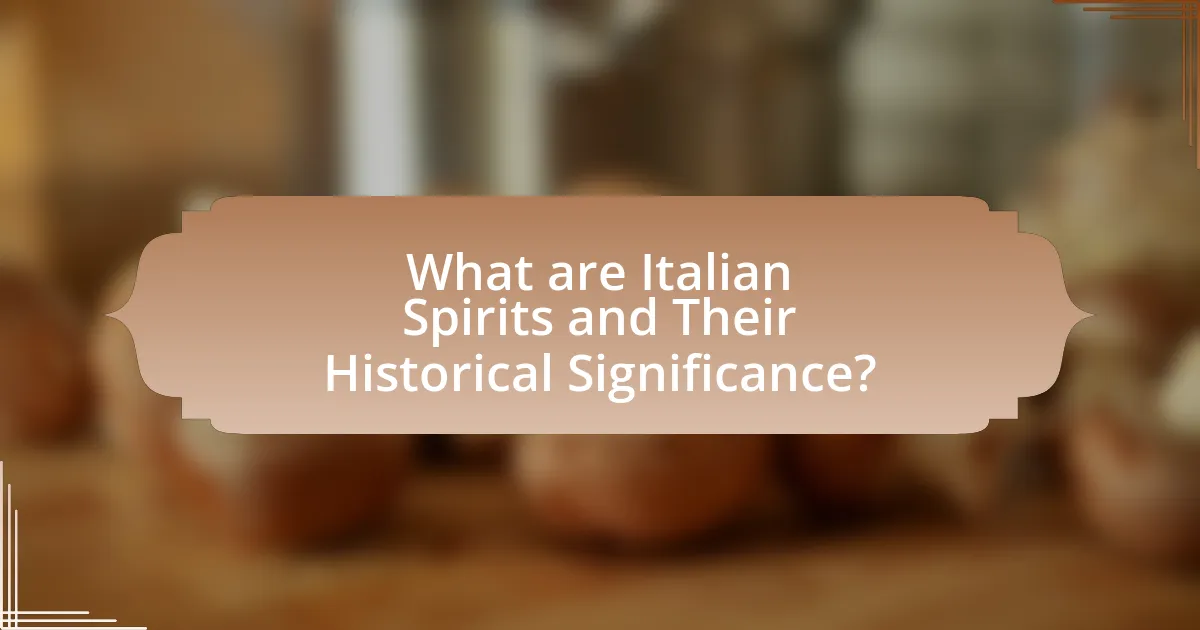
What are Italian Spirits and Their Historical Significance?
Italian spirits are alcoholic beverages produced in Italy, including categories such as grappa, amaro, vermouth, and limoncello, each with distinct flavors and production methods. Historically, these spirits have played a significant role in Italian culture and cuisine, often used in traditional rituals, celebrations, and as digestifs to aid digestion after meals. For instance, vermouth originated in the 18th century in Turin and became a key ingredient in classic cocktails like the Martini and Negroni, showcasing its influence on modern mixology. Additionally, amaro, a herbal liqueur, has roots dating back to the Middle Ages, reflecting the medicinal practices of the time and contributing to the contemporary cocktail scene with its complex flavor profiles.
How have Italian spirits evolved over time?
Italian spirits have evolved significantly over time, transitioning from traditional, locally produced beverages to globally recognized brands and styles. Historically, Italian spirits like grappa and amaro were crafted using local ingredients and methods, reflecting regional flavors and customs. In the 20th century, the introduction of industrial production methods and marketing strategies led to the globalization of Italian spirits, making them accessible worldwide. This evolution is evidenced by the rise of iconic brands such as Campari and Aperol, which have become staples in modern cocktail culture, influencing drink recipes and trends globally. The integration of Italian spirits into contemporary mixology showcases their adaptability and enduring appeal, highlighting their role in shaping the cocktail landscape today.
What are the key historical milestones in the development of Italian spirits?
The key historical milestones in the development of Italian spirits include the establishment of the first documented distilleries in the 11th century, the creation of vermouth in the 18th century, and the rise of amaro production in the 19th century. The first documented distilleries, such as those in the region of Friuli, marked the beginning of a tradition of spirit production in Italy. In the 1700s, the invention of vermouth in Turin by Antonio Benedetto Carpano introduced a fortified wine that would become essential in cocktails. The 19th century saw the proliferation of amaro, herbal liqueurs that gained popularity for their complex flavors and digestive properties, influencing modern cocktail culture significantly. These milestones collectively shaped the landscape of Italian spirits, contributing to their global recognition and integration into contemporary mixology.
How did regional variations influence the types of Italian spirits produced?
Regional variations significantly influenced the types of Italian spirits produced by dictating the local ingredients, climate, and cultural practices. For instance, in the northern regions like Piedmont, the use of herbs and botanicals in spirits such as vermouth reflects the area’s rich agricultural diversity and tradition of herbal medicine. Conversely, southern regions like Sicily emphasize citrus fruits in their liqueurs, such as limoncello, due to the warmer climate and abundant lemon cultivation. These regional characteristics not only shaped the flavor profiles of the spirits but also contributed to distinct production methods, resulting in a wide variety of Italian spirits that cater to local tastes and traditions.
What are the most popular types of Italian spirits?
The most popular types of Italian spirits include Grappa, Limoncello, Amaretto, and Campari. Grappa is a distilled spirit made from grape pomace, often enjoyed as a digestif. Limoncello, a lemon-flavored liqueur, is traditionally served chilled after meals. Amaretto, an almond-flavored liqueur, is commonly used in cocktails and desserts. Campari, a bitter aperitif, is a key ingredient in classic cocktails like the Negroni. These spirits are integral to Italian culture and have significantly influenced modern cocktail recipes globally.
What distinguishes Amaro from other Italian spirits?
Amaro is distinguished from other Italian spirits by its unique blend of bitter and herbal flavors, which are derived from a variety of botanicals, roots, and spices. Unlike other Italian spirits such as grappa or limoncello, which are typically sweeter or more straightforward in flavor, Amaro offers a complex taste profile that can vary significantly between brands and regions. This complexity is often achieved through a meticulous infusion process, where ingredients are steeped in alcohol, allowing for a rich and layered flavor experience. The historical roots of Amaro date back to the 19th century, when it was originally crafted for medicinal purposes, further emphasizing its distinctive character compared to other spirits that do not share this herbal tradition.
How do Italian liqueurs like Limoncello and Grappa differ in flavor profiles?
Limoncello and Grappa differ significantly in flavor profiles; Limoncello is a sweet, lemon-flavored liqueur, while Grappa is a strong, aromatic spirit made from grape pomace. Limoncello’s flavor is characterized by its bright citrus notes, sweetness, and refreshing quality, often enjoyed chilled as a digestif. In contrast, Grappa has a robust, complex flavor profile that can include fruity, floral, and herbal notes, depending on the grape variety used, and is typically consumed in smaller quantities due to its higher alcohol content. The distinct ingredients and production methods of each liqueur contribute to these unique flavor experiences.
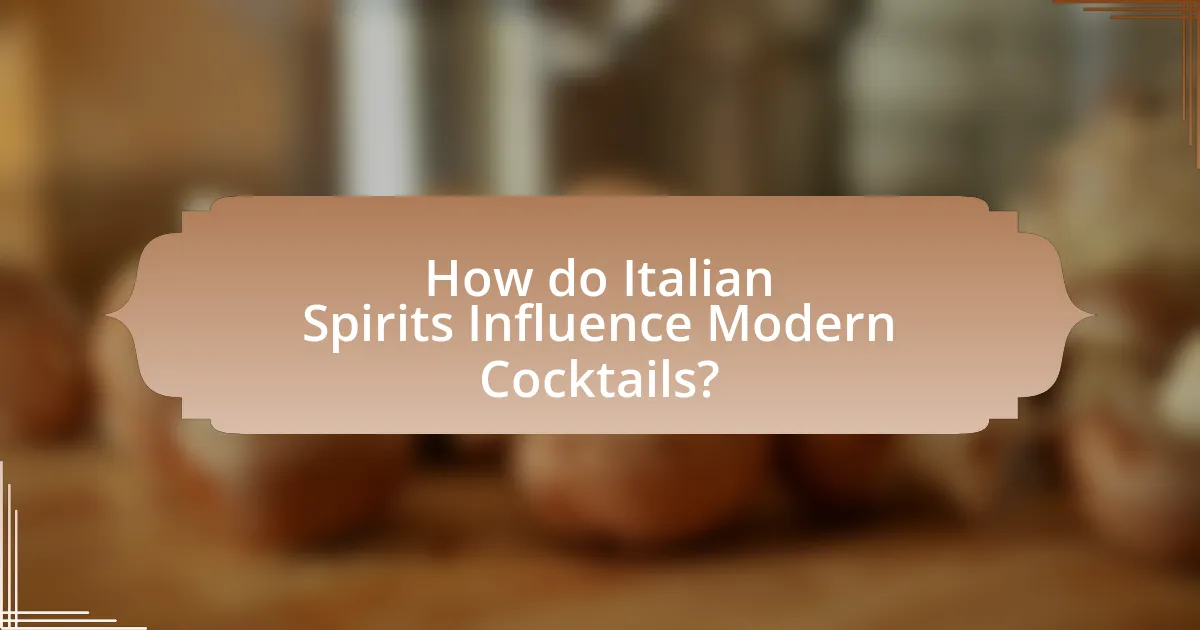
How do Italian Spirits Influence Modern Cocktails?
Italian spirits significantly influence modern cocktails by introducing unique flavors and ingredients that enhance drink complexity. Spirits such as vermouth, amaro, and grappa are integral to contemporary mixology, providing a balance of sweetness, bitterness, and herbal notes. For instance, vermouth, a fortified wine flavored with botanicals, is a key component in classic cocktails like the Martini and Negroni, which have seen a resurgence in popularity. Additionally, amaro, with its diverse flavor profiles ranging from sweet to bitter, is increasingly used in craft cocktails, allowing bartenders to create innovative drinks that appeal to modern palates. The historical significance of these spirits, rooted in Italian culture and tradition, further solidifies their role in shaping cocktail trends today.
What role do Italian spirits play in contemporary cocktail culture?
Italian spirits play a significant role in contemporary cocktail culture by providing unique flavors and enhancing the complexity of drinks. Spirits such as vermouth, amaro, and grappa are integral to classic and modern cocktails, contributing to the resurgence of aperitivo culture and the craft cocktail movement. For instance, vermouth is essential in cocktails like the Negroni and Martini, while amaro adds depth to drinks like the Paper Plane. The use of these spirits reflects a growing appreciation for artisanal and regional ingredients, with Italian brands gaining popularity among bartenders and consumers alike, as evidenced by the increase in sales of Italian spirits in the global market.
How have bartenders integrated Italian spirits into classic cocktail recipes?
Bartenders have integrated Italian spirits into classic cocktail recipes by substituting traditional ingredients with Italian options, enhancing flavor profiles and introducing new dimensions to familiar drinks. For example, the Negroni, originally made with gin, has seen variations using Italian vermouth and amaro, which add herbal complexity and sweetness. Additionally, the use of Italian liqueurs like Aperol and Campari in cocktails such as the Spritz has popularized these spirits, showcasing their versatility and appeal. This integration reflects a broader trend in mixology where Italian spirits are celebrated for their quality and unique characteristics, influencing cocktail culture globally.
What are some signature cocktails that highlight Italian spirits?
Signature cocktails that highlight Italian spirits include the Negroni, which combines gin, Campari, and sweet vermouth, showcasing the bitter and herbal qualities of Italian liqueurs. Another example is the Aperol Spritz, made with Aperol, prosecco, and soda water, emphasizing the refreshing and vibrant nature of Italian aperitifs. The Americano, featuring Campari, sweet vermouth, and soda water, also highlights the rich tradition of Italian bitters. Each of these cocktails reflects the unique flavors and cultural significance of Italian spirits in modern mixology.
Why are Italian spirits favored in mixology today?
Italian spirits are favored in mixology today due to their unique flavors and versatility, which enhance cocktail creativity. The distinct profiles of Italian spirits, such as vermouth, amaro, and grappa, offer a wide range of taste experiences, from bitter to sweet, allowing mixologists to craft complex and balanced drinks. For instance, vermouth has seen a resurgence in classic cocktails like the Negroni and Martini, contributing to its popularity. Additionally, the trend towards artisanal and craft cocktails has led to a growing appreciation for high-quality Italian spirits, which are often made using traditional methods and local ingredients, further solidifying their place in contemporary mixology.
What flavor characteristics make Italian spirits appealing to modern palates?
Italian spirits are appealing to modern palates due to their complex flavor profiles, which often combine herbal, citrus, and bitter notes. These characteristics cater to contemporary tastes that favor nuanced and balanced flavors, making them versatile for cocktails. For instance, spirits like Aperol and Campari offer a blend of sweetness and bitterness, enhancing the overall taste experience in mixed drinks. Additionally, the use of high-quality, natural ingredients in Italian spirits contributes to their authenticity and depth, aligning with the growing consumer preference for artisanal and craft beverages.
How do Italian spirits enhance the overall cocktail experience?
Italian spirits enhance the overall cocktail experience by providing unique flavors and aromas that elevate the complexity of drinks. These spirits, such as vermouth, amaro, and grappa, are crafted using traditional methods and a variety of botanicals, which contribute to their distinctive profiles. For instance, vermouth is known for its herbal and sweet notes, making it a key ingredient in classic cocktails like the Negroni and Martini. Additionally, amaro offers a bittersweet flavor that can balance sweetness in cocktails, while grappa adds a robust character. The use of these spirits not only enriches the taste but also adds cultural depth, reflecting Italy’s rich culinary heritage.
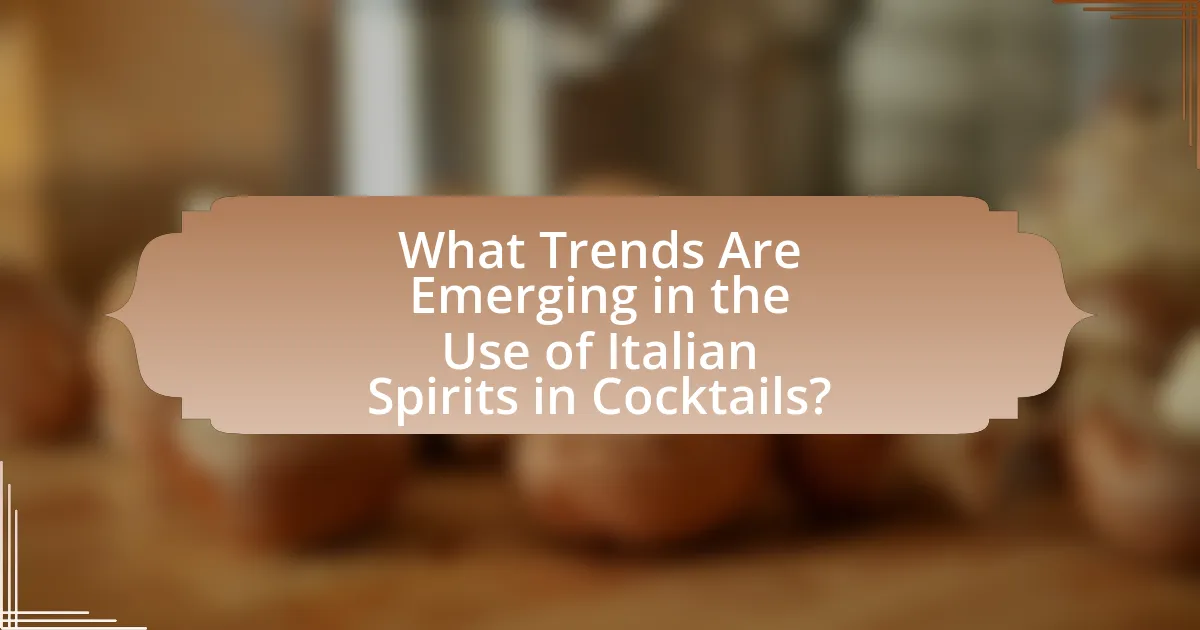
What Trends Are Emerging in the Use of Italian Spirits in Cocktails?
Emerging trends in the use of Italian spirits in cocktails include a growing preference for amari, vermouth, and grappa, reflecting a shift towards complex flavors and artisanal production. Bartenders are increasingly incorporating these spirits into classic and contemporary cocktails, enhancing depth and sophistication. For instance, the use of amari in cocktails like the Negroni has surged, with a 2022 report indicating a 30% increase in amaro-based drinks in bars across the U.S. This trend highlights a broader consumer interest in bitter and herbal profiles, aligning with the craft cocktail movement that values quality and authenticity.
How are craft cocktail bars utilizing Italian spirits creatively?
Craft cocktail bars are creatively utilizing Italian spirits by incorporating them into innovative cocktail recipes that highlight their unique flavors and characteristics. For instance, bartenders are blending Italian vermouths and amari with local ingredients to create signature drinks that reflect regional tastes while paying homage to Italian traditions. This approach not only enhances the complexity of cocktails but also introduces patrons to the diverse profiles of Italian spirits, such as the herbal notes of Fernet or the citrus brightness of Limoncello. Additionally, craft cocktail bars often experiment with techniques like barrel-aging or infusing Italian spirits with seasonal fruits, further elevating the drinking experience and showcasing the versatility of these spirits in modern mixology.
What innovative techniques are bartenders using with Italian spirits?
Bartenders are employing innovative techniques such as barrel-aging, fat-washing, and molecular mixology with Italian spirits. Barrel-aging involves maturing spirits like vermouth or amaro in wooden barrels to enhance flavor complexity, a method that has gained popularity for its ability to impart unique characteristics. Fat-washing, which infuses spirits with fats like bacon or butter, is used to create rich, savory cocktails that complement the herbal notes of Italian spirits. Molecular mixology techniques, including spherification and foaming, allow bartenders to create visually striking and texturally interesting cocktails that elevate the drinking experience. These methods reflect a trend towards creativity and experimentation in cocktail crafting, particularly with the diverse flavor profiles of Italian spirits.
How are seasonal ingredients paired with Italian spirits in cocktails?
Seasonal ingredients are paired with Italian spirits in cocktails by utilizing fresh produce that reflects the time of year, enhancing the flavor profile and authenticity of the drink. For example, spring cocktails may incorporate herbs like basil or seasonal fruits such as strawberries, which complement the herbal notes of spirits like gin or Aperol. In summer, refreshing ingredients like watermelon or citrus fruits are often combined with lighter Italian spirits such as Limoncello or Prosecco, creating vibrant and refreshing cocktails. Autumn brings ingredients like apples and pears, which pair well with richer spirits like Amaretto or Grappa, while winter cocktails may feature spices and citrus, harmonizing with the warmth of spirits like Negroni or Campari. This approach not only highlights the natural flavors of the ingredients but also aligns with the Italian culinary tradition of using seasonal produce, thereby enhancing the overall cocktail experience.
What are the best practices for incorporating Italian spirits into cocktail menus?
The best practices for incorporating Italian spirits into cocktail menus include selecting a diverse range of spirits, understanding their flavor profiles, and creating balanced cocktails that highlight these unique characteristics. Italian spirits such as vermouth, amaro, and grappa offer distinct flavors that can enhance cocktails; for example, vermouth adds herbal complexity, while amaro provides bittersweet notes.
Additionally, utilizing traditional Italian cocktail recipes, such as the Negroni or Spritz, can serve as a foundation for innovation. It is essential to educate staff about these spirits to ensure they can effectively communicate their qualities to customers. Furthermore, seasonal ingredients and local produce can be paired with Italian spirits to create fresh, contemporary cocktails that resonate with current trends.
By focusing on these practices, bars can effectively showcase Italian spirits, appealing to both traditionalists and modern cocktail enthusiasts.
How can bartenders educate customers about Italian spirits?
Bartenders can educate customers about Italian spirits by offering tastings, providing detailed descriptions of each spirit’s origin and flavor profile, and incorporating Italian spirits into signature cocktails. For instance, bartenders can host events that feature various Italian spirits like Amaro, Grappa, and Limoncello, explaining their historical significance and traditional uses in Italian culture. This approach not only enhances customer knowledge but also encourages appreciation for the complexity and versatility of these spirits in modern cocktails.
What tips can home mixologists use to experiment with Italian spirits?
Home mixologists can experiment with Italian spirits by incorporating them into classic cocktails, utilizing their unique flavors to create innovative drinks. For instance, using vermouth in a Negroni or Aperol in a spritz allows for a blend of traditional and contemporary tastes. Additionally, they should explore the use of amaro, which offers a complex flavor profile that can enhance both sweet and bitter cocktails.
Mixologists can also experiment with different ratios and combinations of Italian spirits to discover new flavor dynamics; for example, adjusting the balance of gin and vermouth in a Martini can yield a distinctively Italian twist. Furthermore, garnishing with fresh herbs or citrus can elevate the aromatic experience, making the cocktails more appealing.
Research indicates that the use of Italian spirits in cocktails has increased by 30% in recent years, reflecting their growing popularity and versatility in modern mixology. This trend encourages home mixologists to be adventurous and creative with their drink-making.
